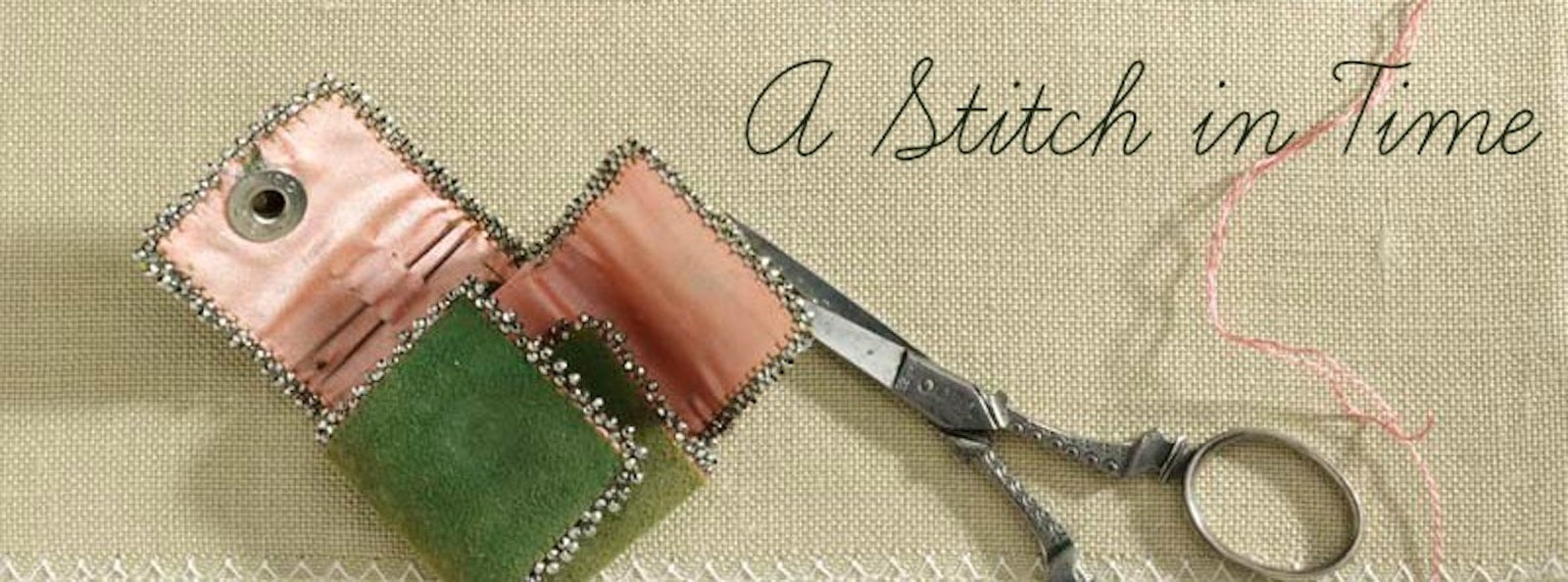The versatile Vandyke or Van Dyke stitch is a variable-width stitch with a distinctive, centrally raised plait or braid. It is rather unique among embroidery stitches because it does not have multiple names. It does have, however, a number of variations that deal with leg length and spacing of the stitches.
The Vandyke stitch (which has no relationship to the Vandyke stitch used in smocking), a collar, and a distinctive beard shape, certainly were named after the great Flemish painter, Anthony Van Dyck (1599–1641), who immortalized the collar and beard in his portraits of England’s Charles I (1600–1649) and other notables of the period. The stitch, collar, and beard share a common characteristic—the chevron shape.
The Vandyke stitch may be worked on evenweave fabrics, such as Aida and canvas, or on nonevenweave fabrics such as linen or satin. To prevent puckers or distortions when working this stitch, work under tension by using an embroidery hoop or frame.
The Vandyke stitch may be worked vertically (top to bottom) or horizontally (in either direction). By using an even tension on the thread (not tight) and keeping the thread slightly snug at the central braid area, the characteristic plait will be well defined.
There are two distinct ways to stitch the Vandyke stitch. Figure 1 represents the more commonly practiced method. Note that the needle slides under the previous loop and does not pierce the fabric at the midpoint of the loop of the stitch after the first tacking stitch. It’s important to keep the plait in the middle of the stitch. To accomplish this, gently pull the working thread toward the beginning of the row and then hold down the loop portion of the stitch with your thumb while stitching the second leg of the stitch. An alternate, although more time-consuming, way to keep the plait in the middle is to work each stitch by piercing the fabric at the midpoint of the loop of the stitch. Parallel slanted lines are produced on the back of the fabric after the first tacking stitch from the carry of the thread from the previous stitch ending on the right side of the row and the next stitch beginning at the left side of the row. Unfortunately, some needlework books provide erroneous diagrams with the back of the Vandyke stitch producing parallel horizontal lines. Figure 2 illustrates the second method of working the Vandyke stitch that is used often in needlepoint.
Left to Right: Figure 1, 2, & 3
Individual stitches may be placed closely together so that none of the background fabric is seen; this is referred to as a Closed Vandyke ( Figure 3). The stitch is often referred to as an Open Vandyke when the stitches are spaced farther apart and the background fabric shows. The legs of the stitches may vary in length to create leaf shapes (Figure 4) or undulating bands (Figure 5); they also may be of equal length for a single stitch or a row of stitches. On a single stitch, however, the leg lengths can vary on each side of the plait (Figure 6). The stitch legs may also be nearly nonexistent (Figure 7), creating a narrow, plaited row similar to hair braids. The leg lengths may also be stitched nearly horizontal (Figure 8). Almost any type of thread may be used for the Vandyke stitch as long as it’s appropriate for the background fabric or canvas. A lustrous or shiny thread will accent the central plait area because the reflected light will intensify the various thread angles. A soft, full thread more easily fills in the area between stitches, which is better for filling in such motifs as leaves and petals. The central plait of the Vandyke stitch creates the midrib or central vein of these plant parts. Carefully select the thread type to create the effect you want.
Left to Right: Figure 4, 5, & 6
Although the Vandyke stitch is usually portrayed in a straight line or row, a gentle wavy or curved line is easily stitched and useful for filling in motif shapes and backgrounds. Other suggested uses for the Vandyke stitch include straight or wavy borders and bands, textured stripes, and outlines for furry animals or hair. Another interesting application for the Vandyke stitch is to use it as a couching stitch for cords, ribbons, or threads to be laid on the fabric surface (Figure 9).
Top Left: Figure 7. Top Right: Figure 8. Bottom: Figure 9.
The Vandyke stitch is a fun and easy stitch to learn but may take a bit of practice to keep the plait centrally located. Expand your repertoire of useful stitches by giving the Vandyke stitch a try. Deanna
This third installment of Deanna’s stitch tutorials originally appeared in the May/June 2002 issue of PieceWork, along with instructions for stitching a Celtic knot band sampler. Deanna is PieceWork’s needlework technical editor; she previously was the editor of The Needleworker magazine. Stay tuned for more stitch tutorials from Deanna in the weeks ahead! Read the entire "Stitch in Time" series!
Featured Image: Scissors and needle case courtesy of Loene McIntyre. Photo by Joe Coca.




